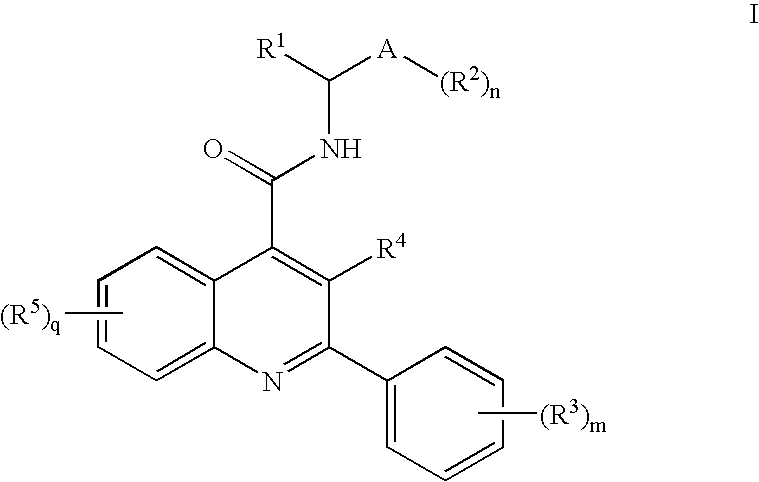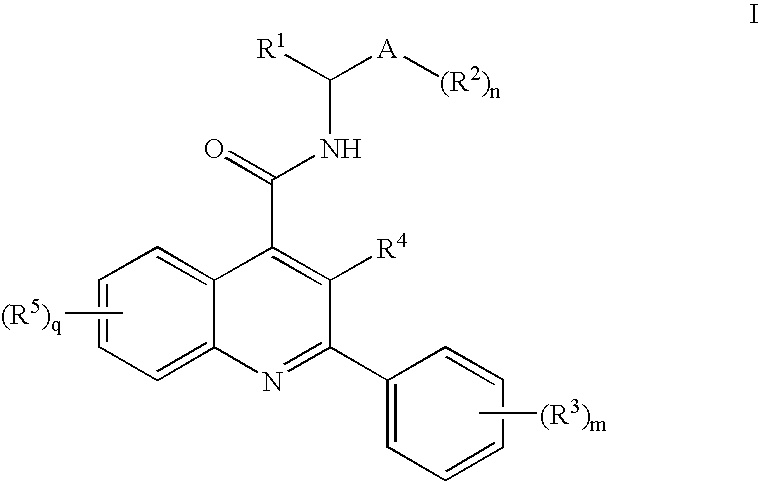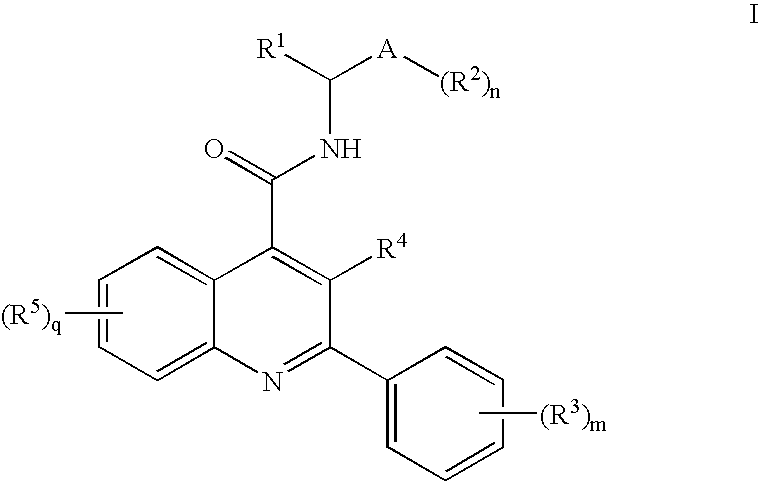Alkylnitrile Quinolines as Nk-3 Receptor Ligands
a technology of nk-3 receptor and alkylnitrile quinolines, which is applied in the field of quinoline derivatives, can solve the problem of limiting the potential to evaluate these compounds in many appropriate disease models
- Summary
- Abstract
- Description
- Claims
- Application Information
AI Technical Summary
Benefits of technology
Problems solved by technology
Method used
Image
Examples
example 1
N—((S)-2-cyano-1-phenylethyl)-3-hydroxy-2-phenylquinoline-4-carboxamide
[0103]
This material was prepared as follows.
(a) ((R)-2-Hydroxy-1-phenyl-ethyl)-carbamic acid benzyl ester
[0104]
[0105]A solution of (R)-2-amino-2-phenyl-ethanol (3.0 g, 21.8 mmol) and triethyl amine (4.5 mL, 32.8 mmol) was dissolved in methylene chloride (60 mL). To this was added benzyl chloroformate (3.4 mL, 24 mmol) and the solution was stirred at room temperature overnight. The solution was then washed with pH 7 buffer, the organic layer was concentrated (MgSO4) and purified by flash silica chromatography using a gradient of 1-5% methanol in methylene chloride to afford the product as a white solid (3.2 g).
(b) Toluene-4-sulfonic acid (R)-2-benzyloxycarbonylamino-2-phenyl-ethyl ester
[0106]
[0107]A solution of ((R)-2-hydroxy-1-phenyl-ethyl)-carbamic acid benzyl ester (1.0 g, 3.7 mmol) and triethylamine (771 uL, 5.5 mmol) was dissolved in methylene chloride. To this was added tosyl chloride (1.05 g, 5.5 mmol) and ...
example 2
3-Amino-N—[(S)-2-cyano-1-1-phenylethyl]-2-(3-fluorophenyl)quinolin-4-carboxamide (2)
[0113]
[0114]The compound of Example 2 was prepared in accord with the following Scheme:
[0115]A solution of 3-amino-2-(3-fluorophenyl)quinoline-4-carboxylic acid (56.4 mg, 0.2 mmol), HOBT hydrate (46.3 mg, 0.3 mmol), 4-methylmorpholine (55 μl, 0.3 mmol) in tetrahydrofuran (11 ml) was added EDC (57.9 mg, 0.3 mmol) at RT under N2. (S)-3-amino-3-phenylpropanenitrile (1a) (29.2 mg, 0.2 mmol) was then added and the reaction mixture stirred at RT for 3.0 h. All solvent was removed in vacuo and the residue was partitioned between ethyl acetate and 10% aqueous sodium bicarbonate solution. The organic phase was washed with brine, dried over sodium sulfate and then concentrated in vacuo. The residue was purified by chromatography eluting with 15-25% ethyl acetate / hexane to give the title compound (35 mg, 43%) as a solid. 1H NMR (300 MHz, CDCl3) δ 3.05 (d, 1H), 3.31 (d, 1H), 4.9 (b, 2H), 5.6 (q, 1H), 6.99 (m, 1H...
example 3
N-[(1S)-2-cyano-1-phenylethyl]-3-methyl-2-phenylquinoline-4-carboxamide (3)
[0116]
[0117]The compound of Example 3 was prepared in accord with the following Scheme:
[0118]This compound was prepared according to the procedure described for N-[(1S)-2-cyano-1-phenylethyl]-3-hydroxy-2-phenylquinoline-4-carboxamide (1) by reacting (s)-3-amino-3-phenyl-propionitrile (1a) with 3-methyl-2-phenyl-quinoline-4-carboxylic acid (in place of 3-hydroxy-2-phenyl-quinoline-4-carboxylic acid). 1H NMR (300 MHz, DMSO) δ 9.67 (d, J=8.6 Hz, 1H), 8.05 (d, J=8.4 Hz, 1H), 7.77 (s, 1H), 7.58-7.37 (m, 14H), 5.61 (s, 1H), 3.20-3.01 (m, 2H), 2.16 (s, 3H). HRMS m / z 392.1733, calcd for C26H21N3O2 392.1763.
TABLE 1Ex-am-pleStructureName1N-((S)-2-cyano-1-phenylethyl)-3-hydroxy-2-phenylquinoline-4-carboxamide23-amino-N-[(S)-2-cyano-1-1-phenylethyl]-2-(3-fluorophenyl)quinolin-4-carboxamide3N-((S)-2-cyano-1-phenylethyl)-3-methyl-2-phenylquinoline-4-carboxamide4N-((S)-2-cyano-1-phenylethyl)-3-methoxy-2-phenylquinoline-4-ca...
PUM
| Property | Measurement | Unit |
|---|---|---|
| pressure | aaaaa | aaaaa |
| pressure | aaaaa | aaaaa |
| pH | aaaaa | aaaaa |
Abstract
Description
Claims
Application Information
 Login to View More
Login to View More - R&D
- Intellectual Property
- Life Sciences
- Materials
- Tech Scout
- Unparalleled Data Quality
- Higher Quality Content
- 60% Fewer Hallucinations
Browse by: Latest US Patents, China's latest patents, Technical Efficacy Thesaurus, Application Domain, Technology Topic, Popular Technical Reports.
© 2025 PatSnap. All rights reserved.Legal|Privacy policy|Modern Slavery Act Transparency Statement|Sitemap|About US| Contact US: help@patsnap.com



